| |||||||
| Search Forums |
| Advanced Search |
| Go to Page... |
 |
| Search this Thread |  21,362 views |
| | #1 |
| Senior - BHPian | A week's drive through Rajasthan - The bastions of the Mewar Kingdom For a Bengali boy brought up on Abanindranath Tagore's "Raj Kahini" - probably the most romanticized narrative on Rajput history - Rajasthan will remain a special place to visit. The endless stories of sacrifice, bravery and loyalty you have gorged on, inspire a special feeling when you walk (and drive) through the land where they happened. And a special feeling it was to chalk out our first visit to Rajasthan. Since doing an entire state in a week is not possible, we restricted ourselves to South Rajasthan. Geographically known as Kumbhalgarh, Udaipur and Chittor, historically the bastions of the Mewar Kingdom. As a change we added in Ghanerao, a small princely state in Pali district and historically a bridge between the Marwar (Jodhpur) and Mewar (Udaipur) kingdoms. Readers of my travelogues would have noticed the absence of the word "predator" in the title. The first time in 5 years that Predator - my beloved Verna CRDI - did not accompany us. Beleaguered by a small mechanical problem as it was, our choice of steed this time was my wife's 2011 i10 Magna, affectionately called Chhotu. Briefly, the trip itinerary turned out as follows: Day 1 - Drive from Delhi to Kumbhalgarh. Day 2 - Ranakpur Jain Temple. Day 3 - Kumbhalgarh Fort. Day 4 - Drive to Udaipur visiting Haldighati and Eklingji. Day 5 - Chittor the whole day. Day 6 - Sightseeing in Udaipur and drive to Ghanerao Palace Day 7 - Sightseeing in Ghanerao and stay at the Ghanerao Forest Lodge Day 8 - Drive back to Delhi Day 1, 5th January 2014 - Drive to Kumbhalgarh Keeping in mind the horror stories about the Delhi-Jaipur expressway, we planned an early departure from Delhi. At 5 AM we were packed and ready to go, encouraged by the complete lack of fog in the city. The moment we left the Manesar toll plaza, the fog enveloped us. It was pitch dark and visibility was restricted to about 10 mtrs ahead of you. Painful. 5.30 AM  6.30 AM  Sensible thing to do was follow Yadav Ji's bumper while he guided us through the fog.  7.30 AM  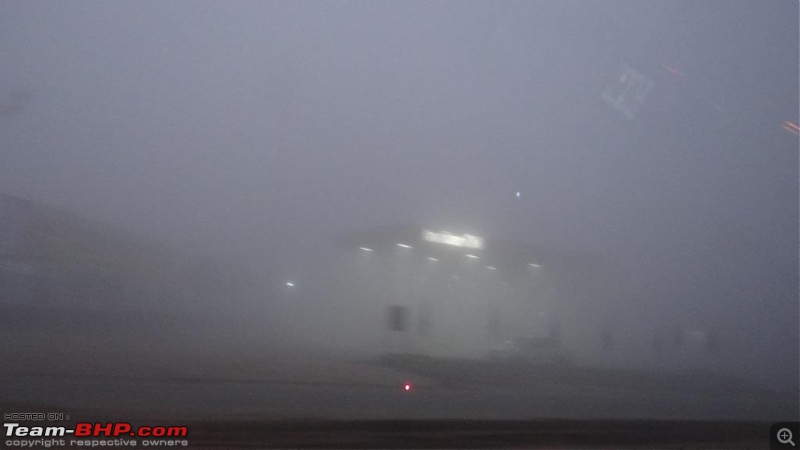 8.30 AM 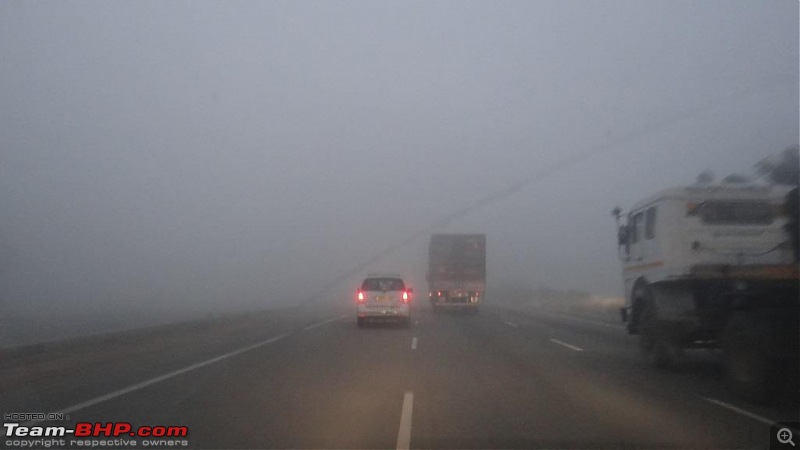 RSTC Ji overtook at full speed and it was evident he knew the road regardless of fog. Sensible thing again was to hang on to his bumper.  By 10 AM visibility had become normal. By this time we were well past Jaipur. Its funny how you can travel hundreds of kilometres without seeing anything you are going past. A tired driver takes his first break.  Finally at 11 the sun came out in full force. It was a pleasurable drive along NH8 all the way to Gomti.     Post Bhim the expressway becomes a dual-lane carriageway. Road quality is tremendous, and twisting and turning, going up and down the winding road is a pleasure for any driver.       From Gomti Chowk you turn right onto SH16. About 15 kms of narrow but well-paved road.    Then you reach a T-point where the left goes to Kumbhalgarh, right to Pali. The left road is a narrower, bumpy road which passes through some villages. 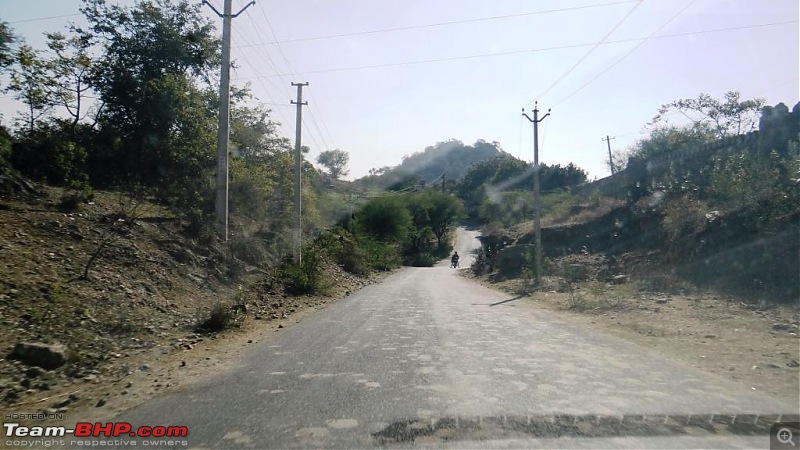   Lakhela Talab on your right side.  The final 5 kms of ascent   We reach Club Mahindra Kumbhalgarh at 3 PM. 10 hours of driving. This is going to be our base for 3 nights. The evening is spent relaxing. Ranakpur beckons tomorrow. 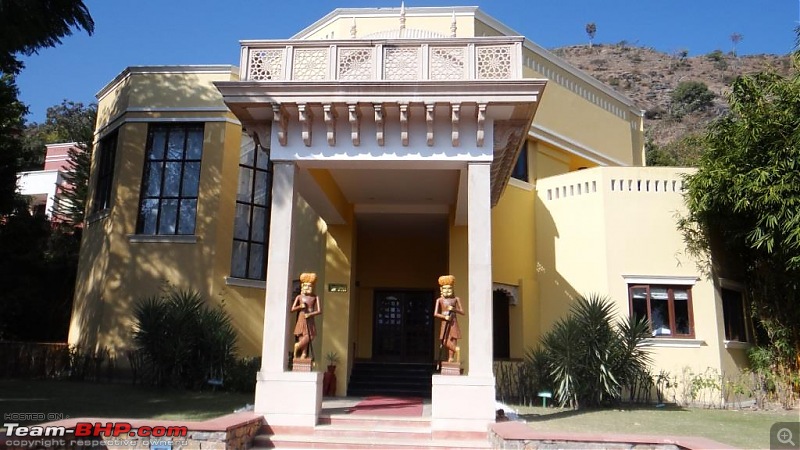 Last edited by Technocrat : 4th February 2014 at 03:09. Reason: Changed PM to AM as requested, Thanks |
| |  (10)
Thanks (10)
Thanks
|
| The following 10 BHPians Thank predatorwheelz for this useful post: | cityvic, darklord, Grr7, GTO, JoseVijay, NetfreakBombay, phamilyman, planet_rocker, pulsar56, Wanderers |
| |
| | #2 |
| Senior - BHPian | Re: A week's drive through Rajasthan - The bastions of the Mewar Kingdom Day 2, 6th January 2014 - Ranakpur Jain Temple After a hearty breakfast, we departed for the Ranakpur Jain Temple.   The small gate on the right leads to the Parashuram Mahadev temple in Kumbhalgarh. We skipped the visit.        There are 2 roads to RJT from Kumbhalgarh. The normal route, passing through Saira, is 65 kms. A shorter route, extremely steep and narrow, saves about 10 kms. While going, we took this route. The i10 bravely negotiated the steep descent. The following is the right-turn to the shorter route. 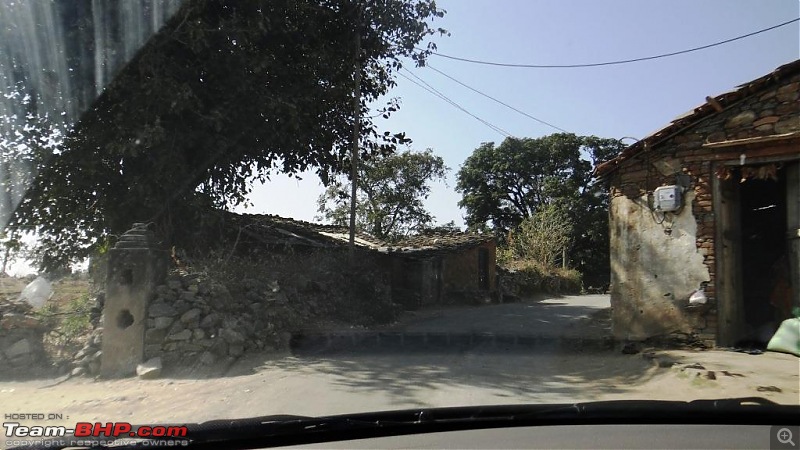 Once negotiated, the road leads to a scenic road which passes through Kumbhalgarh Widlife Sanctuary. Monkeys give you company throughout the route.    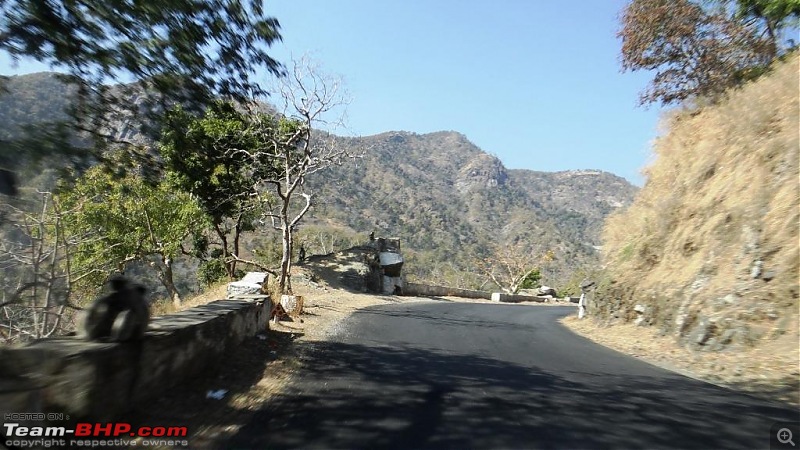  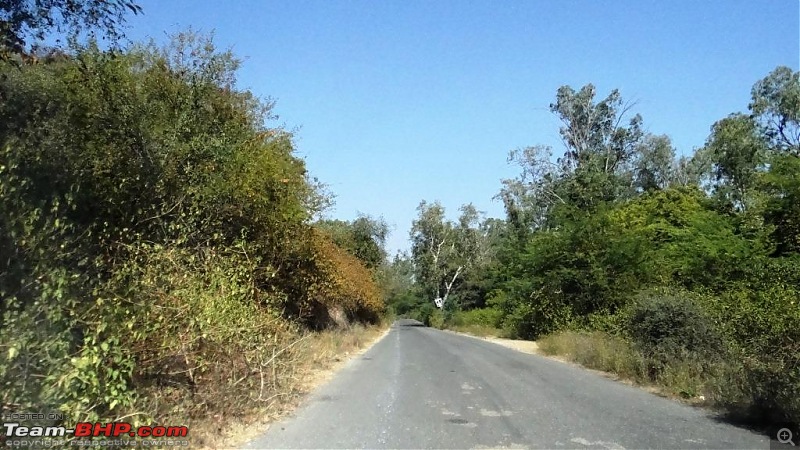 Ranakpur Jain Temple was built in the 15th century by Dhanna Shah, a courtier of the erstwhile Mewar ruler, Rana Kumbha. The Rana donated land and funded building of the magnificent structure.   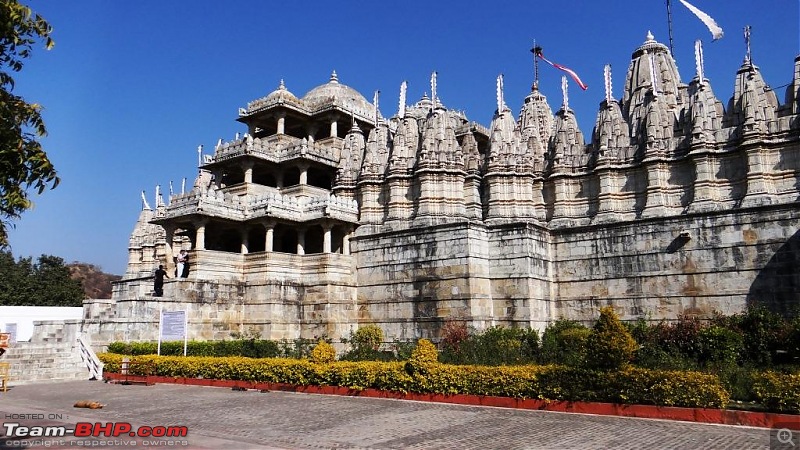 Very well maintained by the current temple trust. Security is heavy, and what you pay for things like camera fees and locker charge go to the temple trust.  All round view of the temple.     (Following text quoted from this site). Temples of Ranakpur present a distinct style of their own. The ceilings of the temples are adorned with foliate scrollwork and geometric patterns. The top and bottom part of the domes are joined by Brackets with figures of deities on them. The most important amongst all the temples within the complex is the Chaumukha Temple, dedicated to the first Jain Tirthankara, Adinath, An enormous basement cover 48,000 sq. feet are. There are four subsidiary shrines, twenty four pillared halls and eight domes supported by over four hundred columns. The total number of columns is 1,444, all which are intricately carved, no two being alike. A corridor around the shrine has niches for the tirthankara images and each niche has its spire or shikhar. Little bells are festooned atop each shikar and their jingling in the breeze creates celestial music. A large number of columns are carved elaborately, and it is said that no two pillars are alike in design. At a space that penetrates through two to three stories, various heights of domes are placed, and their ceilings have sculptures that are unbelievably intricate. Light is abundantly coming inside through gaps between ceilings and from courtyards, highlighting the intertwined spaces and fine carvings all around. The splendor of the space is so pure as the entire temple from the floors to the ceilings is made of white marble. The entire temple area is enclosed within a wall. The beauty of this temple is indeed beyond description. The main 'Chamukha' temple is dedicated to the trithankara Rishabdeoji.   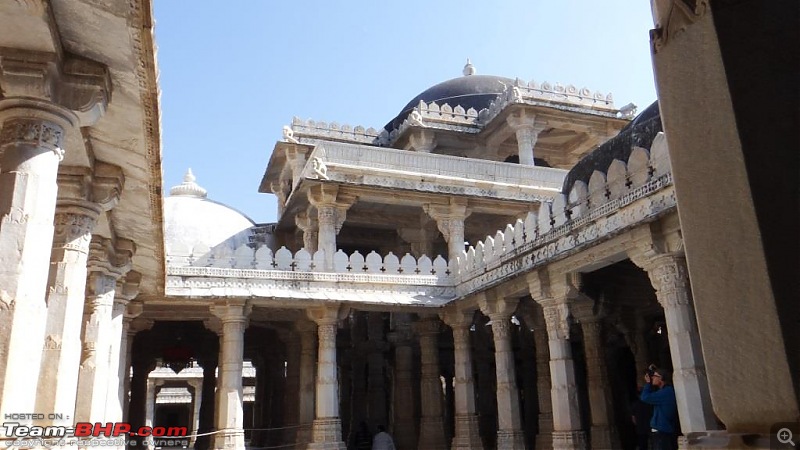  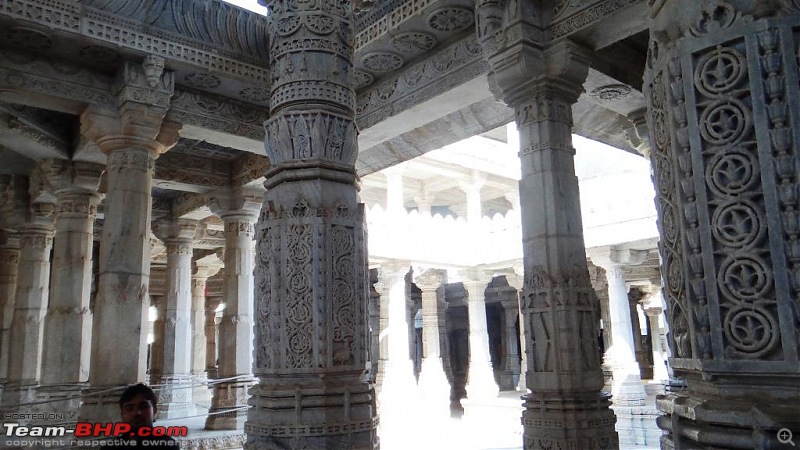  |
| |  (7)
Thanks (7)
Thanks
|
| The following 7 BHPians Thank predatorwheelz for this useful post: | cityvic, darklord, Gannu_1, GTO, JoseVijay, pulsar56, Wanderers |
| | #3 |
| Senior - BHPian | Re: A week's drive through Rajasthan - The bastions of the Mewar Kingdom Day 2 (Continued) We were moving around photographing the wonderful sculptures, when my wife commented "Would have been good to have a guide, isn't it? At least someone could have told us what we are looking at". The Gods must have heard her. Barely 5 minutes later, we met a pretty young woman dressed in a saree, who introduced herself as the daughter of the main priest and offered to show us around. Off we went (along with a large, pious group from Maharashtra) to be introduced to the spectacles. As said before, there are 1444 pillars, no 2 having the same carving. When finished, the architect decided to have just one pillar bent on purpose. This was his way of introducing imperfection, and acknowledging that man can never be as perfect as god.  The most elaborately carved of the domes.  It is said that when the temple was nearing completion, Rana Kumbha (the main financier) developed an ego. He decided to have the largest pillar in the temple dedicated to himself, so future pilgrims could know who financed the shrine. Miraculously, his artisans never managed to complete the pillar, as every time they went beyond a point, the pillar would damage/destroy itself. Finally Kumbha saw sense and decided to leave the pillar unfinished. This is the pillar (I went around the thing trying to find which part was unfinished. Couldn't find any  . But what do I know?) . But what do I know?) Most Mewar temples I've seen come with a particular carving, their rendition of the reptile "Thakshak". According to our guide the Thakshak acted as a deterrent both against bad luck, as well as Muslim invaders who considered the Thakshak inauspicious. 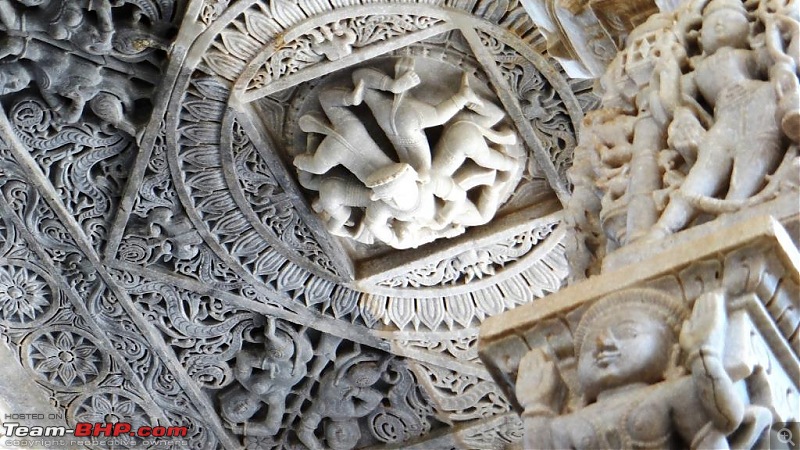 This Vishnu sculpture is the most delicate of the stone carvings. Only the centre point (the image of Vishnu) is attached to the ceiling, and the entire shroud around him is "floating". Amazing artistry!  The wheel of life  The roof of the main temple (Chaumukha) forms the highest point of the shrine.  The figure you see in the centre is the representation of Dhanna Shah, the creator of the temple. His figurine is placed in a way (as per his wish) that he always gazes upon the deity, hands folded in respect.  This elaborate carving, which you sight above you just after entering the temple, is the representation of the word "Om". It is said if you position yourself under the sign and offer prayer to Adinath, your wish comes true.  Even the step at the temple entrance is heavily sculptured.  To the left of the temple complex is a huge Dharamshala. Individual rooms are donated by people in memory of their loved ones. 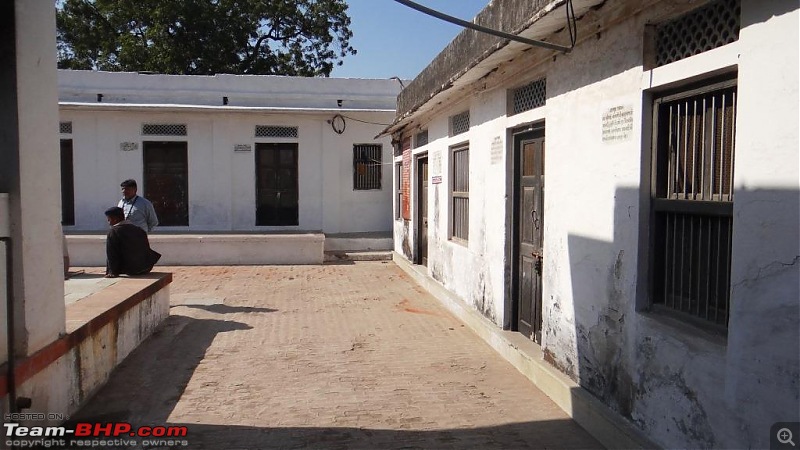 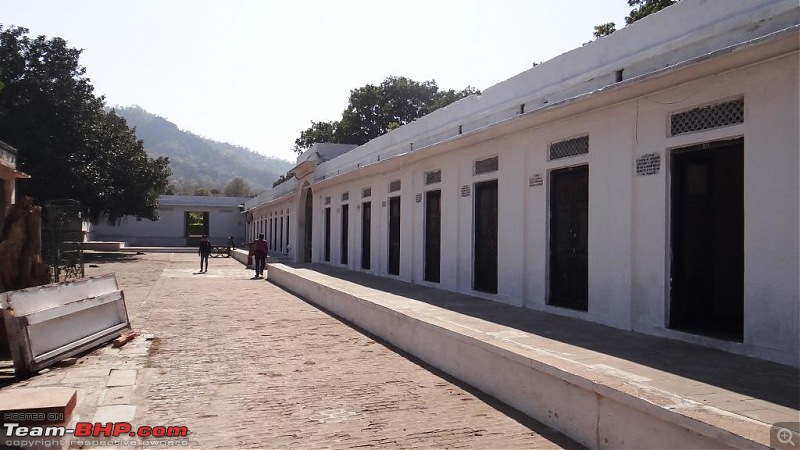 The large hall serves free meals. 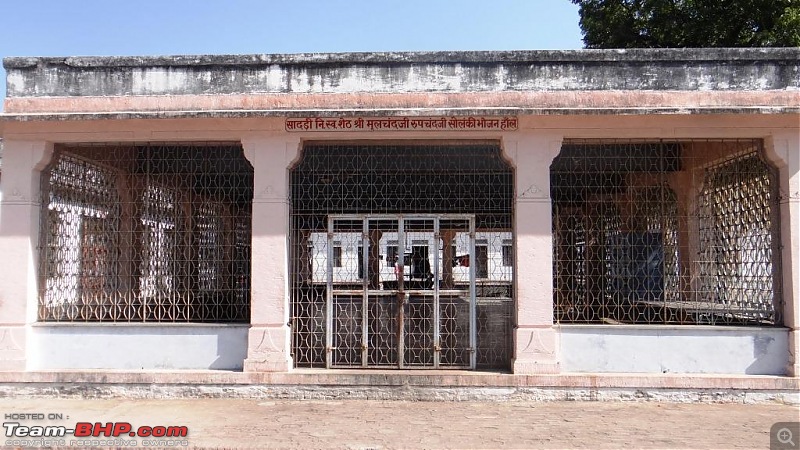 Well-maintained gardens.  With some tailed friends for company.  In the same area is a Parsavnath temple, which the artisans built in their spare time. WOW  . We tried to enter, but a particularly large and noisy group was bursting out of the seams of the temple. So we stayed content with a pic from the distance. . We tried to enter, but a particularly large and noisy group was bursting out of the seams of the temple. So we stayed content with a pic from the distance. A few small temples within the same complex. 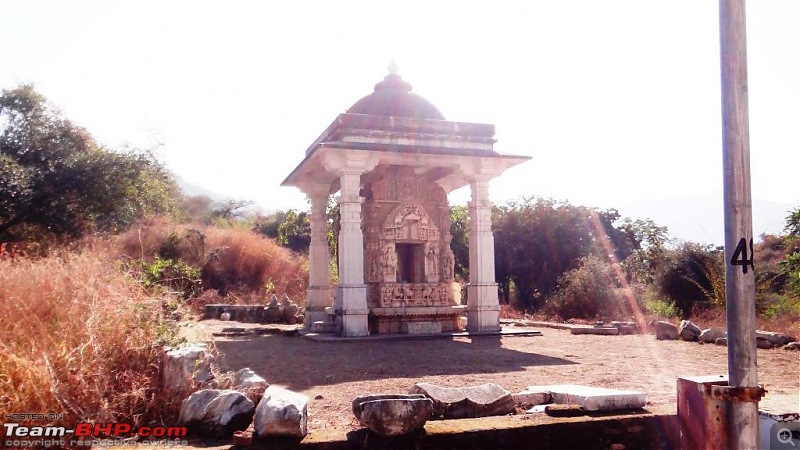  By this time we were seriously hungry, so we departed looking for a decent restaurant. Barely 400mtrs away from the temple gate was RTDC's Hotel Shilpi.  If I ever visited RJT again, I'd stay at Shilpi for a night. Just for location, location and location! Perched atop a hillock with just a few rooms (sharing a common balcony) and one suite, all overlooking the valley.  Easychairs in front of the rooms  This is the view they look out into.  The suite with its exclusive garden, looking out into the same view. 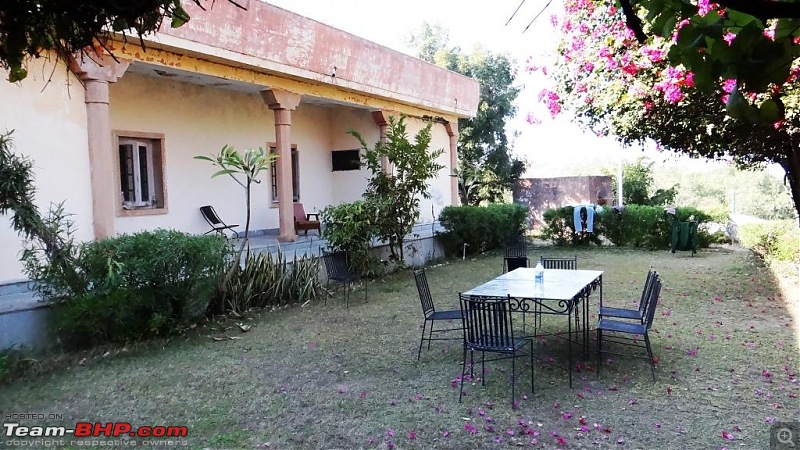 Parting shot. Smug smile after a hearty vegetarian meal.  On our return I was quite confident that the i10 with its 1.1ltr engine and weedy 155 tyres wouldn't be able to make the climb. So we took the longer route through Saira.   Is this funny structure a dam? 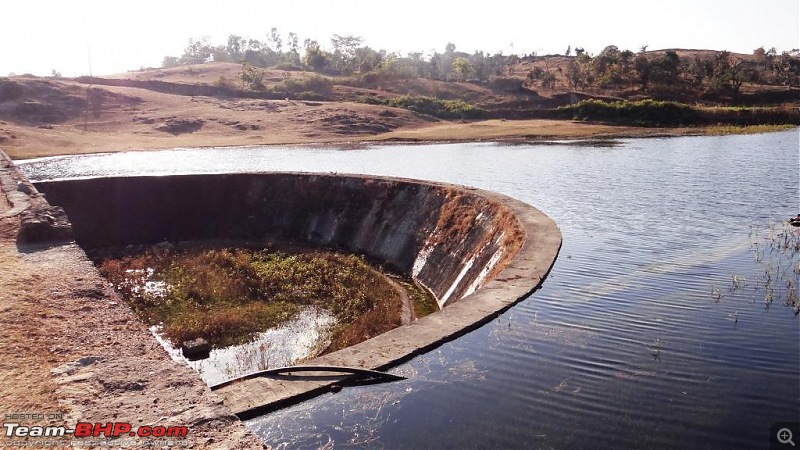 Near the the dam a village boy walked over watching us. We were astounded when he pulled out an ipad and started clicking our pics. So we clicked him clicking us. 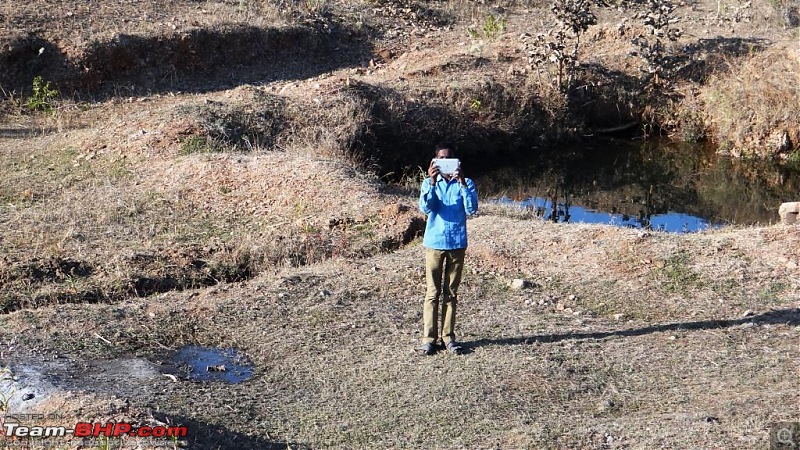 We were back at the hotel before sundown. Next day, Kumbhalgarh fort. Last edited by predatorwheelz : 14th January 2014 at 23:06. |
| |  (8)
Thanks (8)
Thanks
|
| The following 8 BHPians Thank predatorwheelz for this useful post: | cityvic, darklord, GTO, JoseVijay, riturajsharma19, sdp1975, SS-Traveller, toiingg |
| | #4 |
| Senior - BHPian | Re: A week's drive through Rajasthan - The bastions of the Mewar Kingdom Day 3, 7th January 2014 - Kumbhalgarh Fort The Kumbhalgarh Fort was built in 1443 by Rana Kumbha. It was one of 32 forts built in his rule. Kumbhalgarh holds the distinction of being not only the largest fort in Rajasthan, but of having a 36 km long continuous wall - which is in fact the second largest continuous wall in the world, after the Great Wall of China! Kumbhalgarh is of great significance in the history of the Mewar dynasty. In 1536, when Chittor was besieged, the famous Panna Dhai (governess) rescued an infant Udai Singh and took refuge here. The famous Maharana Pratap was also born here. We started our trip to Kumbhalgarh fort, a distance of only 5 kms from our hotel. After 2 kms of twisty accent one encounters a statue of Maharana Pratap where you turn right. Its a steep uphill climb of 3 kms from here.   Aret Pol, the first of seven gates of Kumbhalgarh. 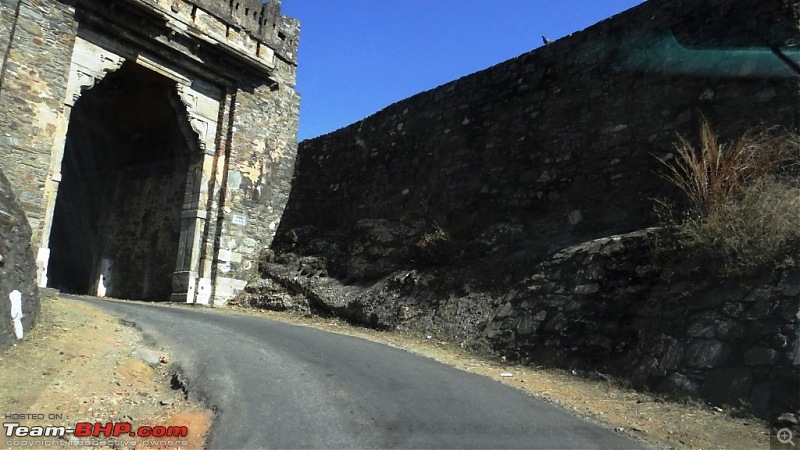    The huge fort looms into view.  Hanuman Pol. The second of seven gates, and the one that leads to the fort compound/parking. 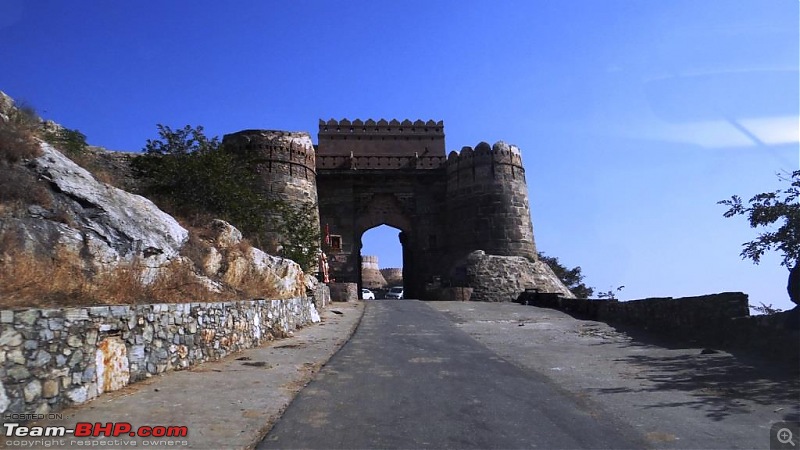 We drive through Hanuman Pol. The tourists are here in their MUVs! 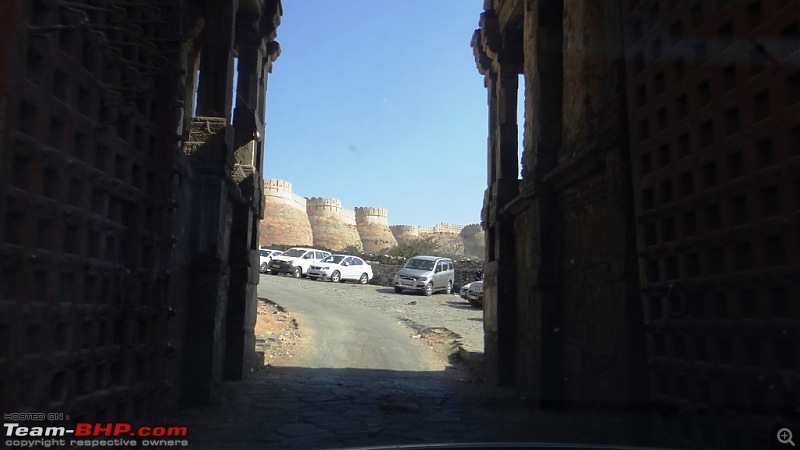 The first view of the massive ramparts and the parking area. Entry is Rs 5 (for Indians), parking is Rs 20 and tickets for the Sound & Light show (from 6.30 PM - 8 PM every evening) are Rs 50. We buy all 3.    Ram Pol, the third gate and the actual entry into the fort complex.  There are 36 temples in Kumbhalgarh, 4 of them visible from the entry itself. This most impressive Parsavnath temple on your right when you enter.  2 other smaller temples.   the long road up.  There are many folklore surrounding Kumbhalgarh, which I will narrate as we go along. The most interesting of these was the construction of the fort itself. When the chief architect started construction of the fort wall, it came down thrice despite his best efforts. Locals informed him that there was a tribal Devi Mata's curse upon this hill, and nothing built my man could stand there until the curse was satiated. So Kumbha and the architect sought advice from a renowned sage. They were informed that the curse could be satiated only by human sacrifice, that too where the victim voluntarily offered himself. According to folklore the sage offered himself for this sacrifice. He would start walking from the base of the hill and a solider with a sword would follow him. Wherever he stopped, the solider would be to behead him. At this point the architect would be required to build a gate. The sage's headless body would still keep on walking, and the trail of his blood would form the reference point for the final path. Of course there are variations of this story, some saying that the volunteer was not the sage himself but a solider in Kumbha's ranks. In any case, a gate (Bhairav Pol) and a temple marks the point where the actual beheading took place.  First overhead sighting of the massive wall.  Bhairav Pol, the point of the sacrifice. The temple is right behind the gate.  Foreboding fortifications. Some artificial.  Some natural, with the rock wall providing inborn defense. 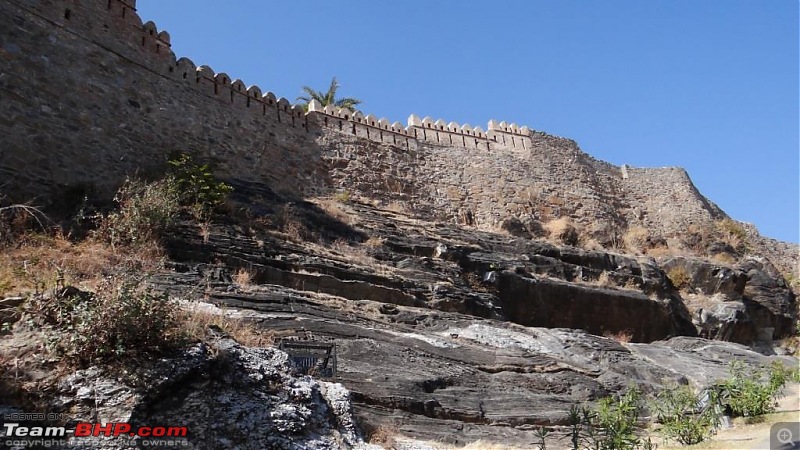 The 5th gate. 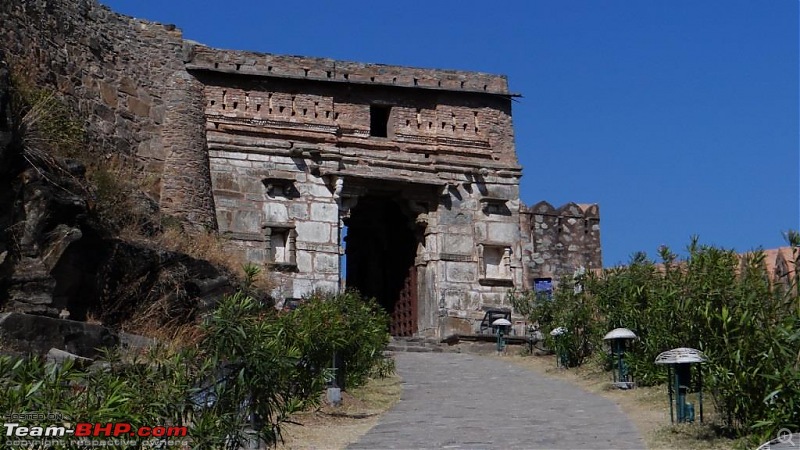 My first introduction to traveller was an article in Outlook traveller some years ago, written by Jug Suraia. Exactly the below structure formed the covering pic. A feeling of deja-vu took over as I clicked it myself.  As one walks higher, one can see the other temples within the fort. Unfortunately these seemed deep inside the fort's bowels, and we had no idea how to get there on foot. 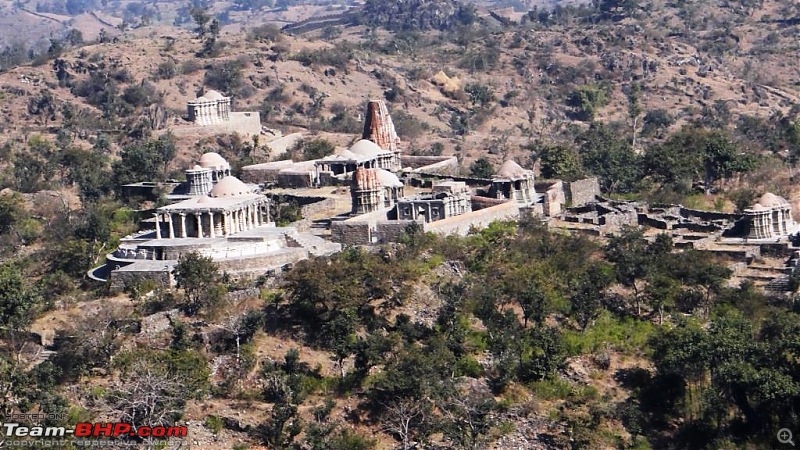 Another view of that fascinating wall.  The last of the gates is up ahead.  I take a breather on a watch-tower.  While wifey goes into the watch tower to err, keep a watch. 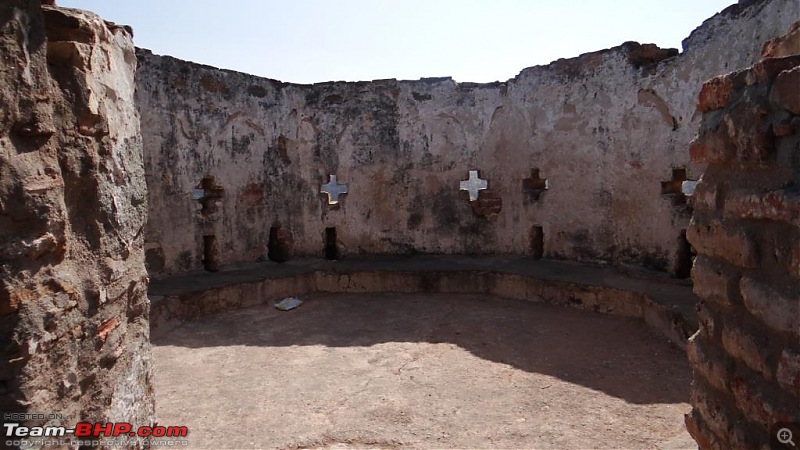 A bit of waste land visible from the watch tower. 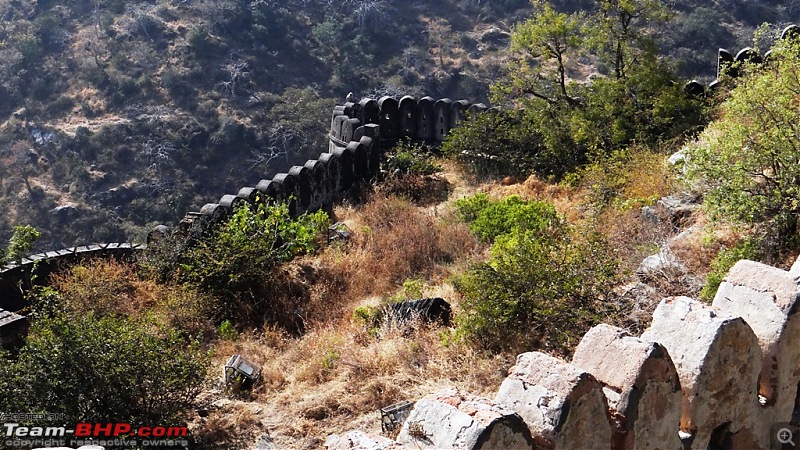 |
| |  (5)
Thanks (5)
Thanks
|
| The following 5 BHPians Thank predatorwheelz for this useful post: | darklord, JoseVijay, pulsar56, SS-Traveller, toiingg |
| | #5 |
| Senior - BHPian | Re: A week's drive through Rajasthan - The bastions of the Mewar Kingdom Day 3 (Continued) (Folklore part 2) As said before, Kumbhalgarh was conquered only once. But there was another attempt, through stealth rather than outright war. A flower girl, who used a goat trail through the jungle to get to the palace everyday, was befriended by the enemy. She was to mark the path by strewing flowers as she went up. In the night, the enemy would use the trail to sneak up into the fort. However the plan got caught before it could be executed. As a warning for future traitors, the poor flower girl was buried alive inside one of the walls you see below.  Once you cross the last gate, the Canon House is to your left.  4 wagons, one of which has the Canon missing.    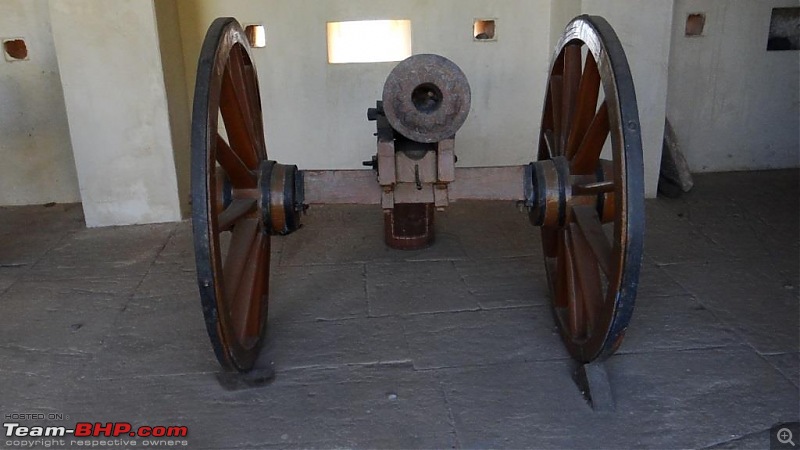 A portion of the fort in ruins (behind the canon house). On the day of our visit there were very few people, so we explored at leisure.   Some more views of the magnificent wall. In the first pic, you can see most of the temples inside the fort, including the legendary Neelkanth Mahadev temple (the square structure to the farthest left). Legend has it that Rana Kumbha was murdered by his son Uday Singh in the midst of his prayers inside this temple. I was surprised to see people living inside the fort too.  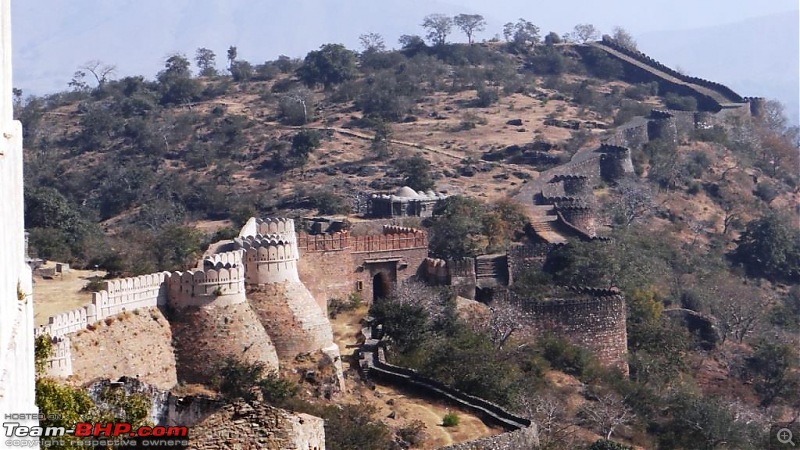 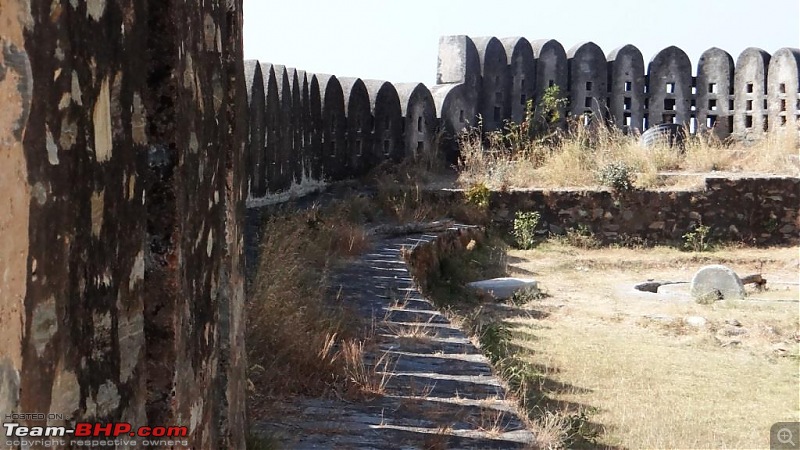 One can see the parking from up there. I wanted to test my camera's zoom skills. There's the normal view of my car in the parking (circled in black).  And that's the view at full zoom.  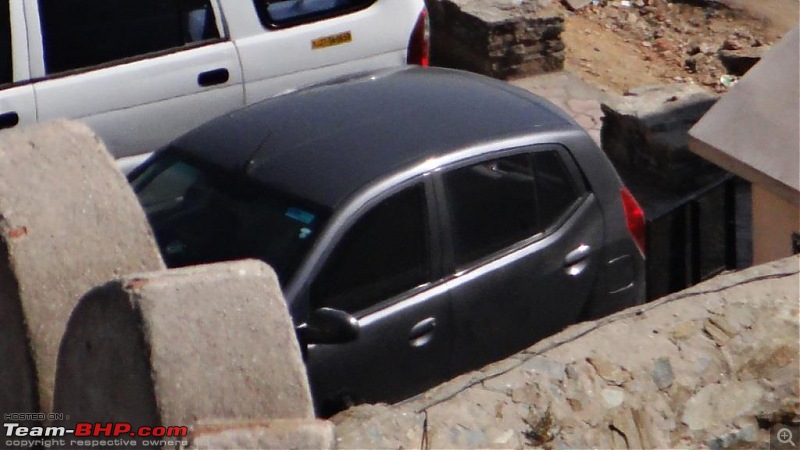 "Lets get into the palace" says wifey and hikes off.  I'm not sure, but this looks like the remains of a persian water wheel.  The last gate viewed from inside the palace grounds. The canon house is to your right from here.  Once inside the palace grounds, you actually witness structures from 2 different eras. The 16th century palace, of Kumbha's and Pratap's time, is a stone structure mostly in ruins. The other is the magnificent Badal Mahal built by Fateh Singh in late 1800s. You can make out which is which era from the photos itself.   A side view of the imposing Badal Mahal  Not sure what this structure is. 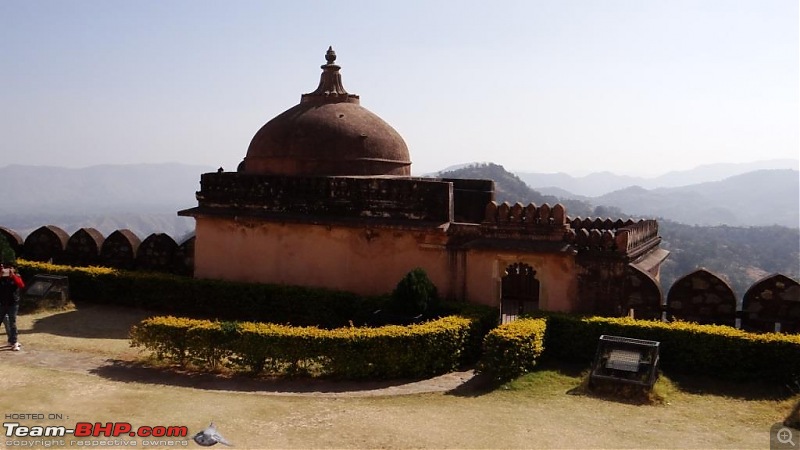 We got into the Badal Mahal to explore. 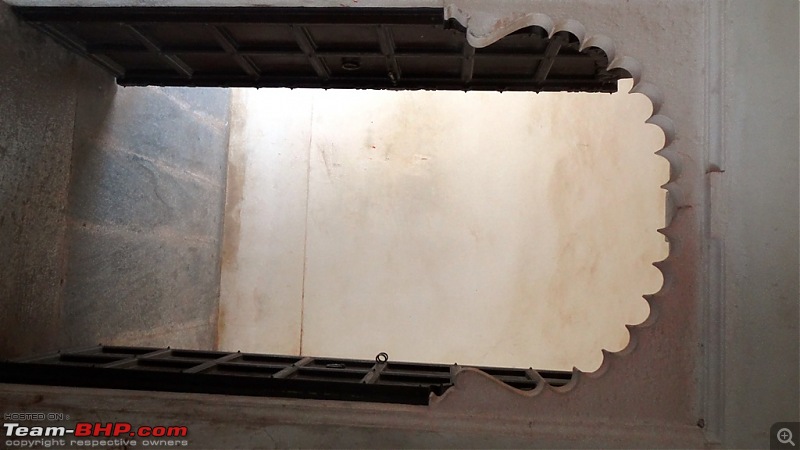 First view of the central courtyard.  Impressive frescoes on the walls of the Queen's chamber.   The Eklingji temple inside the mahal courtyard   A first-floor view of the courtyard.  Not sure why wifey wanted to meditate  . .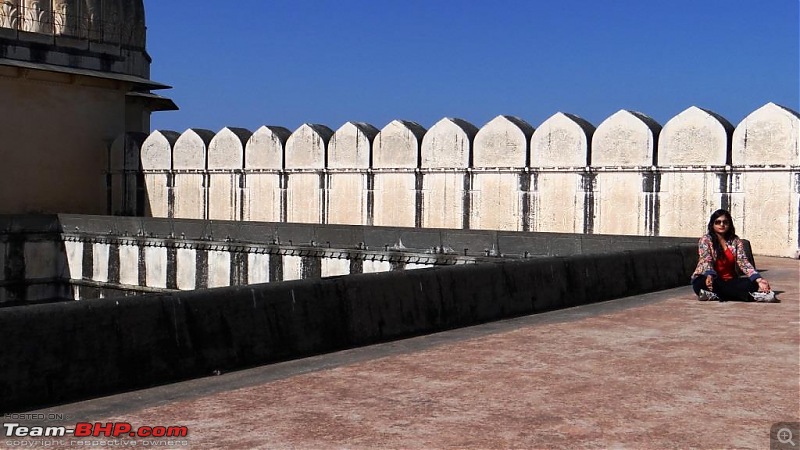 A beautiful Jharokha on the second floor.  And the view it looks out into.  Last edited by predatorwheelz : 26th January 2014 at 14:02. |
| |  (5)
Thanks (5)
Thanks
|
| The following 5 BHPians Thank predatorwheelz for this useful post: | darklord, GTO, JoseVijay, sdp1975, toiingg |
| | #6 |
| Senior - BHPian | Re: A week's drive through Rajasthan - The bastions of the Mewar Kingdom Day 3 (Continued) We get to the roof of the Badal Mahal. True to the name, its very windy.  Once you get past your fat narrator in the foreground  , the view is to die for. , the view is to die for. The wall on the other side of the fort visible from here.  Rana Kumbha's living quarters. A fairly simple structure, now converted into a temple. 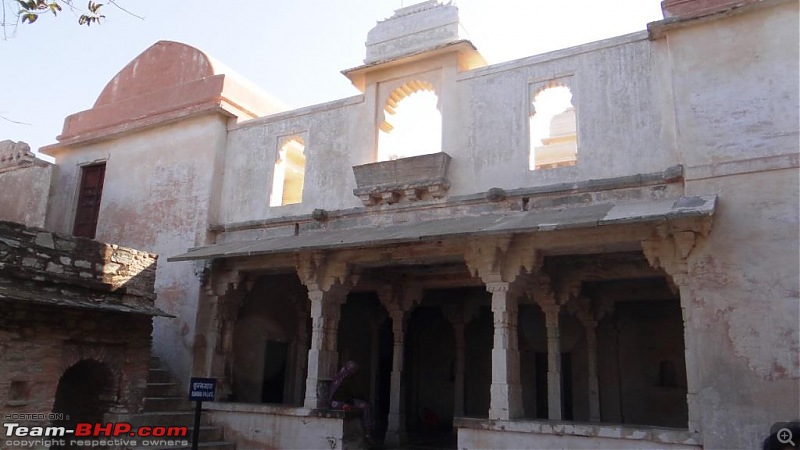  What you see behind the closed iron gate is the room in which Rana Pratap was born. 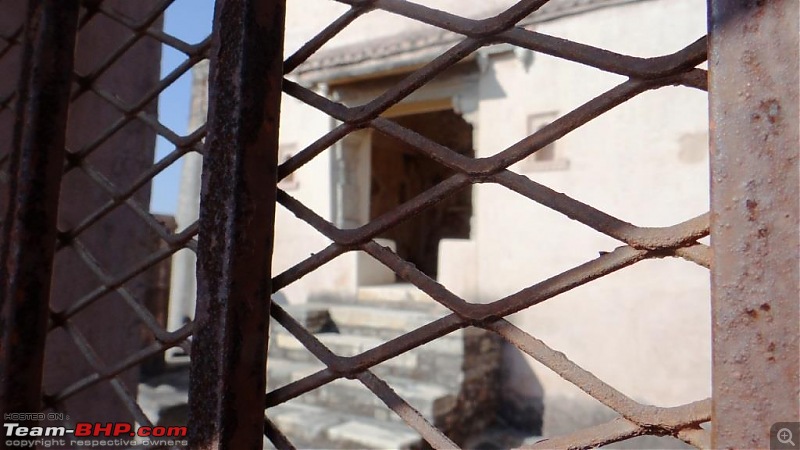 This little guy would do anything to get a penny from us. He even claimed he was Rana Kumbha reborn, and knew the way around his beloved fort better than anyone!  My wife had to have a picture with the little Maharana.  The monkey surveys everything from the top.  We left Kumbhalgarh at 3 PM. A lovely lunch at Aodhi, followed by some rest at our hotel. We were back again for the Son-et-Lumiere (Sound & Light show) at 6.30. A highly dramatized but important historical narrative that you should not miss. We came to know, for example, that this mountain was first discovered by Maurya rulers - descendants of Ashok - who created a small bastion here called Machindragarh in second century AD. It lay in ruins for 14 centuries until Kumbha built his fort here. We also came to know that Kumbha, in order to enable the farmers to work at night, would light huge lamps which consumed 50 kgs of ghee and 100 kgs of cotton every night! A parting shot of the fort, bathed in light.  Club Mahindra Kumbhalgarh I don't believe in showing off hotels we stayed in. If I have to, I know there are dedicated sites for hotel endorsements. But on this trip, we stayed in a few properties which were not only extremely comfortable, but also made for great sights. So on this thread I'll make an exception.  The first of these was CMK, a resort you absolutely should not miss if you visit Kumbhalgarh. A sprawled out property with an amazing restaurant, comfortable rooms, good spa, and lots of activities for the family. Some pics. The view when you enter the main gate.  The reception building  The reception inside 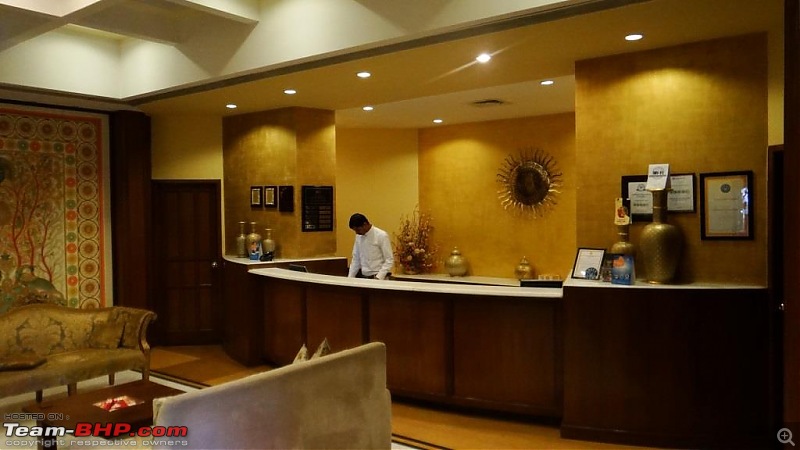 The souvenir shop and travel desk  The restaurant is on the first floor, and this is the waiting area at the base of the stairs. 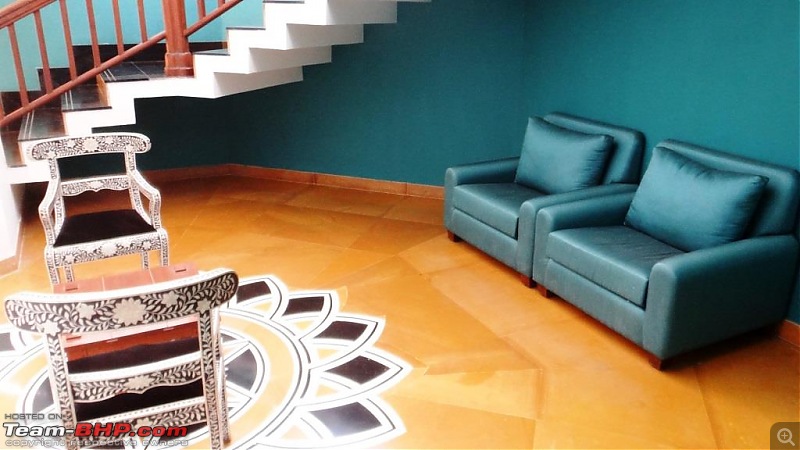 The stairs.  Your breakfast menu for today, sir. 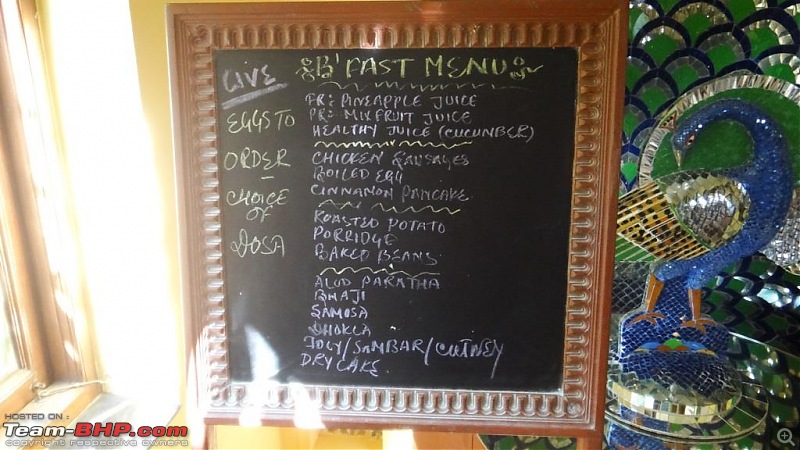 The restaurant seating area.  The restaurant has a wonderful balcony which looks out into the main gate. The view.  Posing at the balcony.  The parking area. Bhpian Rhandle was also here, and his Fortuner (not in the picture) with a fearsome Ironman front bull bar and snorkel made a nice sight in the parking lot.  The entire property is made in "step" fashion along a hillside, so there are plenty of steps leading everywhere. Pictured is a set of steps leading to someone's rooms.  Open air seating area for you to catch some healthy winter sun. Doubles up as an amphitheater.  The lovely swimming pool.  Some more steps leading to somewhere (actually the other wing of the hotel).  They have an open air restaurant and bar, with a wonderful terrace. I sat there to catch some sun, promptly fell asleep. Wifey clicked a pic.  The wing where we stayed in. 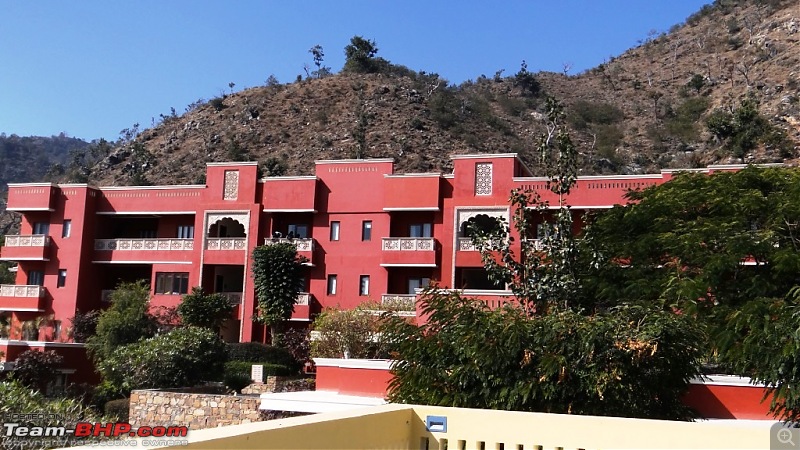 As said before, there's lots for the family to do here. Besides the swimming pool and good spa, there's an indoor playing area, a basketball court, and a badminton court. Besides, you can do quaint stuff like puppet making (wifey did), or pottery (did that too). Here's her working on her puppet. 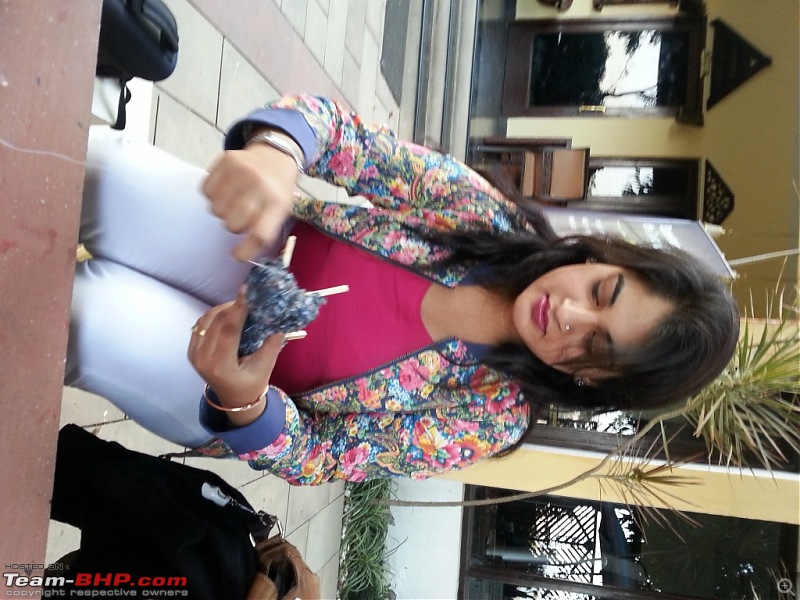 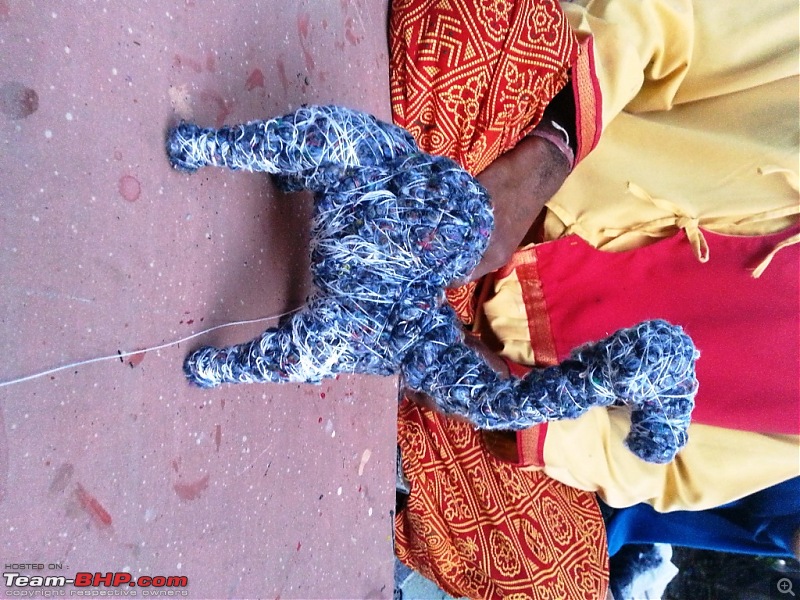 Or just do silly stuff like wearing a Rajasthani Pagdi and posing for pics.   So that was the end of our 3 day, very satisfying Kumbhalgarh visit. The next day, we would leave for Udaipur. We would be visiting Haldighati (where the historical battle between Rana Pratap and Mann Singh took place - now a museum) and Eklingji on the way. |
| |  (4)
Thanks (4)
Thanks
|
| The following 4 BHPians Thank predatorwheelz for this useful post: | cityvic, darklord, JoseVijay, toiingg |
| | #7 |
| Senior - BHPian | Re: A week's drive through Rajasthan - The bastions of the Mewar Kingdom Day 4, 8th January 2014 - Drive from Kumbhalgarh to Udaipur via Haldighati & Eklingji We got up early to catch a brilliant sunrise from our room's balcony.  There are 2 ways to get to Udaipur. The first is of course to get back on NH8 via Gomti. The second (and recommended) is the state highway from Kumbhalgarh to Udaipur. It is less crowded and much much more scenic. Thanks to some smart camera work by my wife, we seem to be "hurtling" towards the destination.   The road passes through some forests.  lakes.  hill sections.  and quaint villages.  Some more scenes along side.  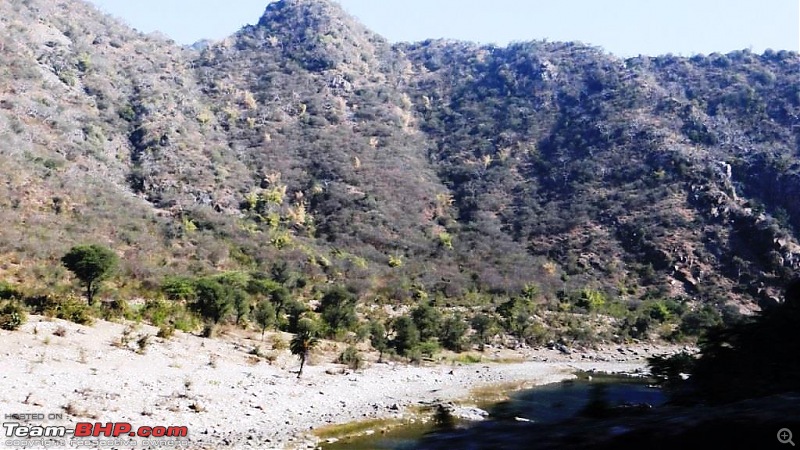    After 36 kms, you take the left to Haldighati. A straight but patchy road.   We are at the Haldighati museum, dedicated to Maharana Pratap.  Maharana Pratap doing Elaan-e-Jung as soon as you enter.  Battle of Haldighati. The text.  And the graphic description of the text.  About the man.  Let me warn you at this point. This really isn't a museum, as there are no exhibits of historical vintage or importance. What you will see here is a graphic description of different events in Maharana Pratap's life, through mannequins and lighting. The events are depicted in no particular chronological order. They also show a (grainy, bad quality) movie depicting the battle of Haldighati. I was quite disappointed. But now that we're here, lets move on. The first exhibit is the royal emblem of Mewar. The man on the right is the Maharana, the one on the left is the representative of the Bheel Adivasis, a tribe that has been on the side of the Mewar rulers in every battle.  Maharana pratap denouncing all royal pleasures. "I will sleep under trees, not royal beds, I will eat on a leaf, not on royal utensils etc etc..till I defeat the Mughal dynasty".  A bad depiction of the Kumbhalgarh fort.  Maharana Pratap doing Elaan -e-jung of the battle of Haldighati.  Assasins come to kill the child Maharana Udai. Panna Dhai sacrifices her own son.  Maharana Pratap strategizes with the Bheel chieftains.  A depiction of the folklore that Maharana Pratap fought (and killed) a tiger with his bare hands.  Pratap mourns a dying Chetak after the steed has rescued his master from the battle of Haldighati.  After the battle of Haldighati, Pratap re-thinks his strategy with his ministers from his hideout in a mountain cave.  Once you come out of the puppet show, there are more puppets depicting rural life (Why???). Haldighati is famous for its locally produced rose extracts (rose water and Gulkand). The vessel below is used for the extraction process.  While there was nothing to see in the puppets, my wife reunited with some old friends.    We move on to Udaipur. |
| |  (4)
Thanks (4)
Thanks
|
| The following 4 BHPians Thank predatorwheelz for this useful post: | cityvic, darklord, JoseVijay, toiingg |
| | #8 |
| Senior - BHPian | Re: A week's drive through Rajasthan - The bastions of the Mewar Kingdom Day 4 (Continued) On this trip we had 2 guides. My faithful Mapmyindia, and Google maps on my wife's android. Truth be told, throughout the trip Google Maps showed us shorter and better routes. After Haldighati, Google Maps showed us a route to Eklingji that was 10 kms shorter than the one suggested by GPS. So we took it.   Just 2 villages on the entire route   I was almost convinced we were lost.  I was also convinced that the road would just end, and we would end up somewhere in a khet.   Until the road opened up into this wonderful uninhabited stretch.  And landed us right back onto NH8.  And we were on the way to Udaipur.  The gate denotes the Eklingji temple.  Unfortunately they don't allow cameras in the temple. Neither do they allow shoes (obviously) or belts (eh). What struck me is, if no leather item was allowed, why do they allow wallets? Anyway, now we're back on our way to Udaipur. The line of cars you see in front, is the result of a overloaded truck holding up traffic on an incline.  Modern day billboards denote the entry into Udaipur.  As does this broken gate from not so modern times.  In the city now.  Our stay for the next 2 days, the wonderful Lalit Laxmi Vilas Palace.  One recommendation for your forthcoming visit to Udaipur. Please visit the wonderful 1559AD restaurant close to the Fateh Sagar Lake. The food (both Indian and Continental) is wonderful, as is the ambience and service.  Take a chair on the balcony.  Or in the garden, beside this little fountain.  Day 4 ended here, as we decided to rest in the hotel for the evening after a hearty lunch. Tomorrow, we go to Chittor, my most anticipated destination of the trip. Last edited by predatorwheelz : 28th January 2014 at 22:44. |
| |  (4)
Thanks (4)
Thanks
|
| The following 4 BHPians Thank predatorwheelz for this useful post: | cityvic, darklord, dean5545, JoseVijay |
| | #9 |
| Senior - BHPian | Re: A week's drive through Rajasthan - The bastions of the Mewar Kingdom Day 5 - Chittorgarh Chittorgarh, a massive 700 acre fort complex, is really the holy grail without which any history of the Mewar dynasty is incomplete. Bappa Rawal, the founder of the Mewar dynasty, conquered it from the erstwhile Mori clan and built his capital here. For the next 900 years Chittor formed the citadel of power in Mewar. Progressively built upon and beautified by his successors, Chittor was only conquered thrice. First by Alauddin Khilji in 1303, who was enamored by the beauty of Rani Padmini. The second by Sultan Bahadur Shah of Gujarat in 1535. The last was by Akbar in 1568. In all 3 occasions the women inside Chittor committed Jauhar - the tradition of burning oneself alive rather than submit to dishonor in the hands of the invaders. More of the history lesson later. As usual, we drove out early from Udaipur. Chittor is about 115 kms from here along the wonderful NH76.  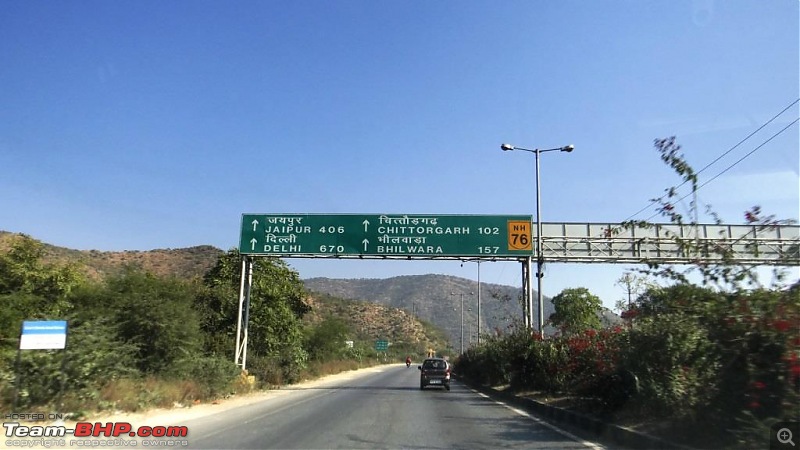 On the day the road was sparsely populated, and we made quick progress.   75 Rs ka toll! Better to pay Rs 105 for the return journey and keep the slip. 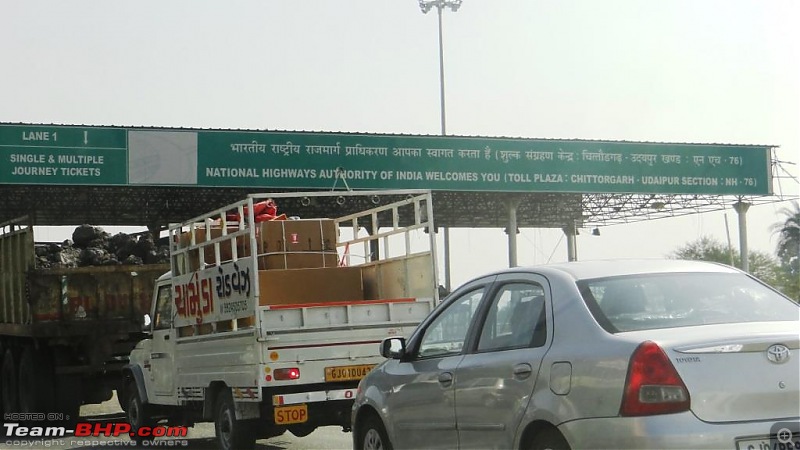 About 50 kms from Chittor you hit a T-point. The straight arm goes on to Kota, the left arm to Chittor.  Note the left arrow in the first signboard.  This is an even better, concrete paved road.   Taxi bhai wants you to chat with him on Whatsapp!  Almost there.   A fork in the road with a confusing dashboard. The left arm goes to Chittor.  You pass under one bridge.  Then a second bridge, after which you turn left into Chittor town.  Driving through town.  The fort looms into view.  This irritating man on the white scooter gave us a headache. Spotted us driving into town and drove up alongside, almost causing an accident. "Guide sir, take me, unofficial guide. Only Rs 300, will give you full tour of fort" and so on. Led us for a good 3 kms before I stopped and clearly explained that we didn't require his services.   We start the ascent to Chittor fort.  At this point, let me disclose something the guidebooks don't tell you. The current entry into Chittor - through 7 gates on the west side - was actually the rear path into Chittor. When the fort was originally built, the actual entrance path (now closed and in ruins) was on the east. In those times, once one entered the fort, they would have to pass through living quarters of common men, army quarters, markets, houses of ministers etc (in that order) before finally reaching the royal palace. Behind the palace (hidden to public view) was the treasury. Now that you enter through the original rear gate, you come across the treasury and palace first, and the other sights later. More as we go along. I have used a google maps image for reference. The black arrow on the right indicates the original gate. The red arrow is the current entrance to Chittor.  Second of the 7 gates. By now I've figured all gates in Mewar are suffixed "Pol", and "Ram", "Laxman", "Bhairon" and "Hanuman" will form at least 4 of the prefixes  . This one is "Bhairon Pol". . This one is "Bhairon Pol".  The third gate, called "Hanuman Pol".  A sharp hairpin bend ahead, followed by a steep ascent.  You can take the stairs, if driving is not your thing!  Laxman Pol  And we're into the inhabited part of Chittor. A proper village as it were.  A guide map at the entrance of the fort complex. You have to buy entry tickets for yourself and for your car. Its better to take your car as you can circle the entire fort (anticlockwise) and see all the sights at your leisure. Otherwise there are autorickshaws, but they don't go all the way.  We were lucky to get a good guide. A 62 year old, certified guide called Mr Rajesh Sharma who's been in this job since 1978. Not only did he know the place like the back of his hand, he told me stories about the film crews he assisted and showed me good photo-ops all along. "I am central government certified guide sir, not RTDC guide" he would proudly say. With Mr Sharma in the car, we take the first corner and head off into exploring Chittor. 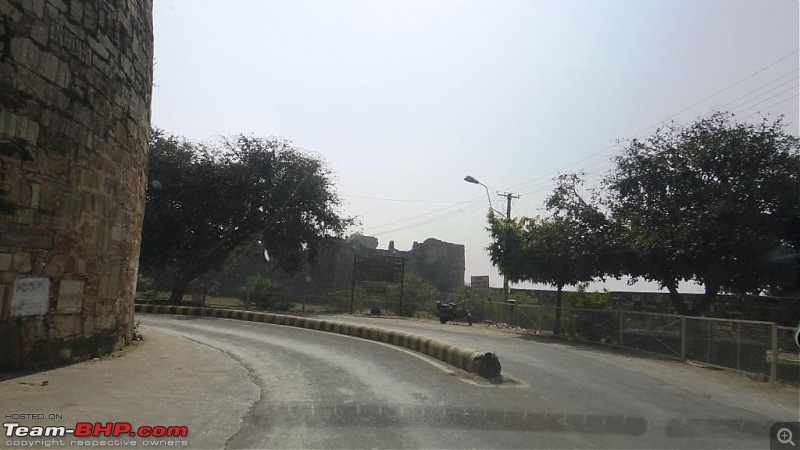 Our first stop, the Royal Palace... Last edited by predatorwheelz : 26th January 2014 at 23:58. |
| |  (5)
Thanks (5)
Thanks
|
| The following 5 BHPians Thank predatorwheelz for this useful post: | cityvic, darklord, JoseVijay, SS-Traveller, Wanderers |
| | #10 |
| Senior - BHPian | Re: A week's drive through Rajasthan - The bastions of the Mewar Kingdom Day 5 (Continued) Our guide leads us into the royal palace.  The Royal palace was built by Rana Kumbha in the early 16th century. A magnificent structure originally, with provisions for keeping horses and elephants. Unfortunately Chittor was ransacked twice in the 16th century itself, and the invaders ransacked and destroyed much of the palace. What you see in the pic below is the remains of the King's side of the palace.   The Zenana mahal. Beautiful jharokhas remain, but the paint and precious stones are lost.   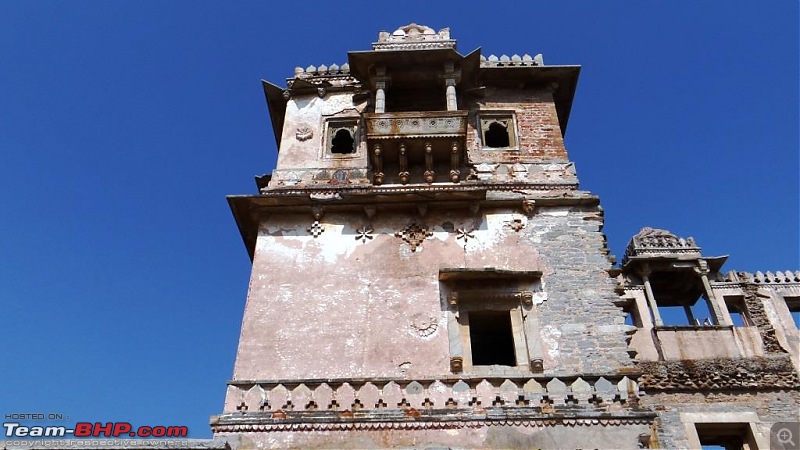 An underground tunnel which leads all the way to Gaumukh Talab (pics coming up later). The royal women used this to travel to the talab for their daily bath.  The palace (or whatever remains of it) was a complex structure with a network of underground tunnels. What you see is another tunnel gate which has been closed off and a temple erected at the entrance.  Ruins of the rear side of the palace.  The modern maharani poses for a photograph. 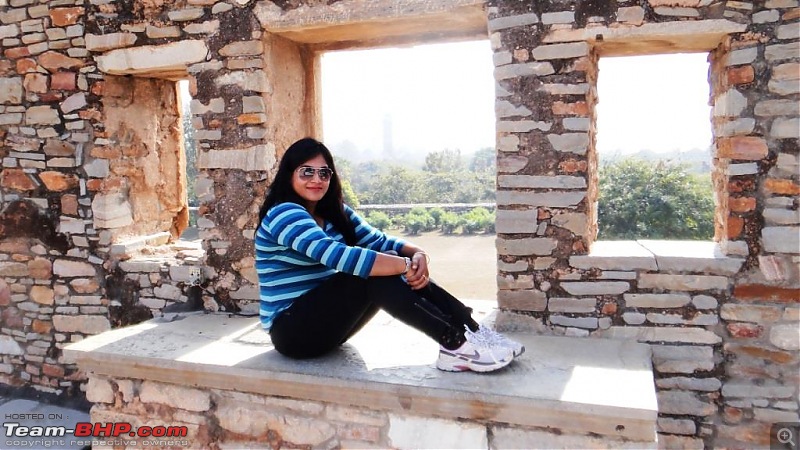 The original entrance gate of the palace. The large dome structure to the extreme right of the gate was the enclosure for elephants. The jharokha to the top left (barely visible) was where the king sat to hold durbar. The ministers and courtiers sat in the balcony beneath, and the public sat in the garden to the right of the picture.  A better view of the King's Jharokha.  Remains of the Nau Lakha Bandar - the royal treasury. Chhotu (our i10) is visible in the background.  2 more chhotus checking out chhotu.  We are done with the palace, so we drive on to the next destination. We cross badi pol. The meaning is self-explanatory.  Our next stop is the Kumbhaswami temple, dedicated to Varaha - one of the avatars of Lord Vishnu. It was renovated by Rana Kumbha.   The temple is shaped like a chariot. Something I've seen in sun temples (Konark) but not Vishnu temples.  Exquisite exterior carvings.  The temple viewed from the front.  The marble work in the interiors has worn off in some places.   But quite prominent in others.  In the same complex is the Meerabai temple. Smaller in size, but of greater religious significance to Hindus. To the uninitiated, Meera Bai was the wife of Bhoj Raj and the daughter-in-law of Rana Sanga. She was a lifelong devotee of Lord Krishna and is rumored to have authored 1300 bhajans for the lord. The temple in the picture below was her place of worship to Krishna.  We finish off with the temple complex and drive to the next destination. 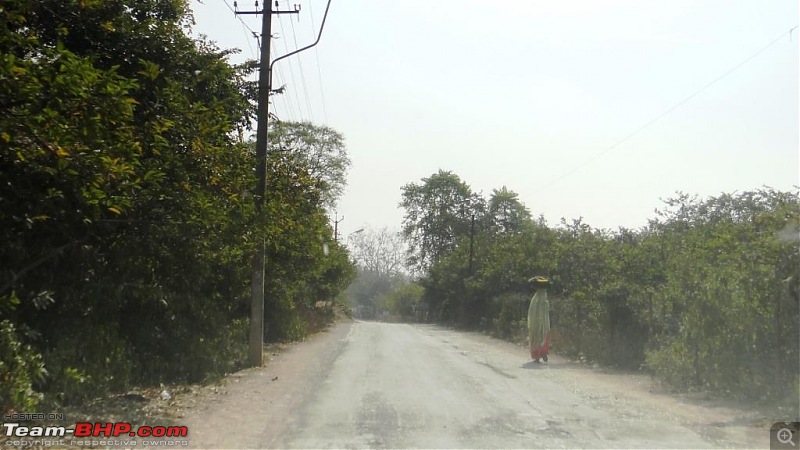 Before we reach, let me warn you. Chittor is full of monkeys (the gray langoor, more specifically). They live in hundreds of thousands all over the fort. Though generally harmless to humans, its a bad idea to provoke them, or carry food items in your hand in open view.  Our guide feeds some monkeys.  The mother giving survival tips to her newborn.  Our next destination, the grand Vijaya Stambh. Vijay Stambha (Hindi: विजय स्तम्भ) or "Tower of Victory" is an imposing structure located in Chittorgarh fort in Rajasthan, India. This tower is the piece-de-resistance of Chittaurgarh. It was constructed by Mewar king Rana Kumbha between 1442 AD and 1449 AD to commemorate his victory over the combined armies of Malwa and Gujarat led by Mahmud Khilji. Dedicated to Vishnu,this 37.19 m high 9 storied tower is one of the most remarkable in India. It is built partly of red sand stone and partly of white marble and is enriched by numerous images of Hindu gods and goddesses with inscriptions at bottom of each. It is believed that the tower took 10 years to be completed. This exemplary piece of architecture stands on a pedestal 10 feet high. Each of the nine stories are distinctly marked with openings and balconies at every face of each story. The interior staircase winds alternately through the central chamber and surrounding gallery. The inscribed slabs in the uppermost story contains genealogy of the rulers of Chittaur from Hamir to Rana Kumbha. The entire tower is covered with architectural ornaments and inscribed images of gods and goddesses, seasons, weapons, musical instruments, etc. Its inscribed sculpture are a veritable text-book of Hindu iconography. The portraits of the architect of this tower Jaita and his 3 sons, Napa, Puja, and Poma are carved on the fifth floor of the tower. There are around 157 narrow steps leading to the terrace from where one can have a beautiful view of Chittorgarh town and the fort. The uppermost floor has been sealed off and is no longer accessible to visitors. (Source - Wikipedia)   |
| |  (6)
Thanks (6)
Thanks
|
| The following 6 BHPians Thank predatorwheelz for this useful post: | cityvic, darklord, JoseVijay, SS-Traveller, toiingg, Wanderers |
| | #11 |
| Senior - BHPian | Re: A week's drive through Rajasthan - The bastions of the Mewar Kingdom Day 5 (Continued) Another view of the Vijaya Stambh.  And some beautiful carvings.   Our next attraction is the site of Rani Karnavati's jauhar. A relic of a horrifying past. 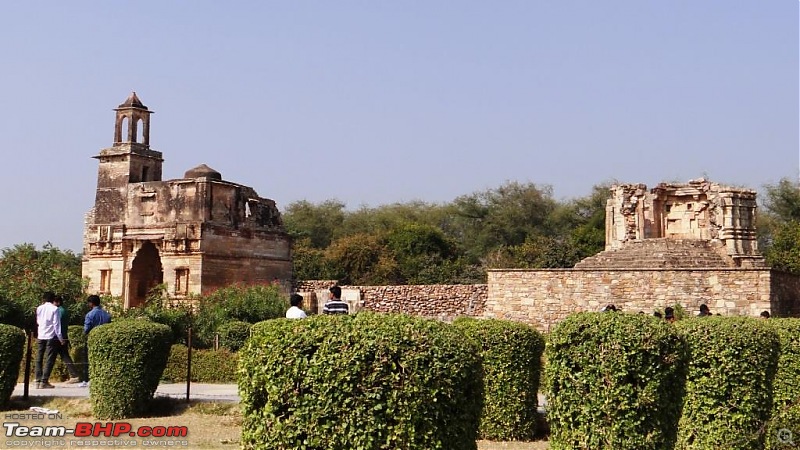 Rani Karnavati was the widow of Rana Sanga. When Bahadur Shah of Gujarat attacked Chittor in 1535, Rani Karnavati committed Jauhar (along with 5000 women) by jumping into the flame at this very site.  Right opposite the Jauhar site is the Samadhishvara temple. A huge temple dedicated to lord Shiva built in the 11th century.  The living quarters of the priests. Till date the current priests live here.  History lesson. 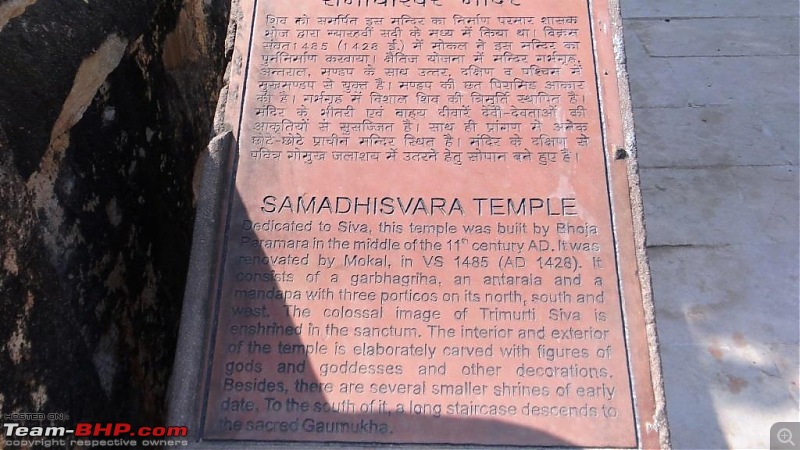 A huge statue of Trimurti Shiva inside the temple.  The Gaumukh reservoir. This is where the tunnel of the bathing queens (you read in the earlier post) opened up into.  The reservoir is apparently fed by underground springs. One has to go down right in there to see the source of the water.  And that's why the reservoir is called Gaumukh, because the outlets of spring water have been designed like err, cow-heads.  Are those tadpoles in the water?  After spending a good amount of time at the reservoir, we drove off for our next destination. On the way we passed by this haunting looking building. "What is this place?" I asked my guide. "Oh, the house of Jaimal and Patta. Don't bother, they were not kings. Let's carry on". "I know who they were" I replied. And for their gallantry alone, their residence deserved a visit.  For the uninitiated, Jaimal and Patta were two chieftains in the army of Rana Uday Singh. When Akbar attacked Chittor, Rana Udai Singh fled to the safety of Udaipur, a city he had built. He left behind Jaimal and Patta, 2 boys aged 15 and 16, leading a convoy of 8,000 warriors and 40,000 bheel adivasis. A long struggle for supremacy ensued. Akbar had to strain his resources to the hilt to turn the siege into victory, but he succeeded. The 2 young boys were killed in battle. For a hair-raising account of the battle of Chittor, read this marvelous article by Jeffrey Say Sack Leong. http://www.historynet.com/battle-for...ss-in-1567.htm  The entrance gate.  The winds blowing through the ruins whispered the history of Jaimal and Patta.   Strangely these 2 parrots flew in when we walked towards the building, and monitored our every move while we moved around. Rebirth?  Valley view.  The third being monitoring us.  The original gate.  We move on to the next sight, another dynamic chapter in the history of Chittor and one of the earliest. The lake palace of Rani Padmini, the queen of Rawal Ratan Singh renowned for her beauty.  It was here that Alauddin Khilji got a glimpse of the queen's beauty, and his madness in trying to possess her led to the first siege of Chittor. As also the first Jauhar. The board says it all.  2 more glimpses of the interiors of the palace.   It is at this point that all public transport terminates. So if you're visiting Chittor on an autorickshaw, you go back. Luckily we were not. So we drive ahead, to catch the remaining sights.  It is said that Chittor had 86 water tanks, some fed by underground springs, some storing rain water. As a result the residents never had a shortage of water in 9 centuries. A glimpse of such an irrelevant tank.  |
| |  (4)
Thanks (4)
Thanks
|
| The following 4 BHPians Thank predatorwheelz for this useful post: | cityvic, darklord, JoseVijay, Wanderers |
| |
| | #12 |
| Senior - BHPian | Re: A week's drive through Rajasthan - The bastions of the Mewar Kingdom Day 5 (Continued) We have reached the end of the perimeter, the road turns left.  The government established a deer park in Chittor. Our guide tells us they forgot to create natural conditions for survival of the forest, especially a water source. All the deer died. Now only the board remains.  Over what is now a sparsely populated route, we sight old broken temples. Not famous because no one wrote a history lesson on its origin.  And another, attached to a reservoir.  Our guide makes us stop at this unmarked temple. It was built in the 12th century it says, before Kumbha, before any of the famous sights we have seen so far. The carvings on this temple are the most intricate in all of Chittor, he says.  We get down to inspect.  And golly, he's right. The carvings are not only intricate, they're also largely unmolested by time. A better grade of stone perhaps?  The facade.  We get inside, to find its a Shiva temple.  No Pujaris, no pilgrims. Just some more monkeys giving us company.  A beautifully carved wall.  Chhotu awaits to go to the next destination.  And we oblige. 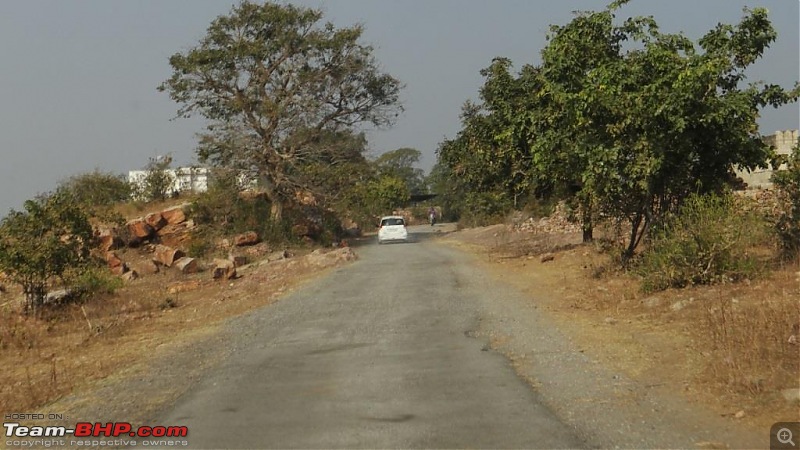 We have now come a half circle and are on the East side. This, ladies and gentlemen, is the original gate of Chittor.  The original pathway to the gate. A walk down not to be attempted, as its broken in some places and missing in others.  The walls of time.  Behind my wife is the beautiful valley the gate overlooks.  The gates. 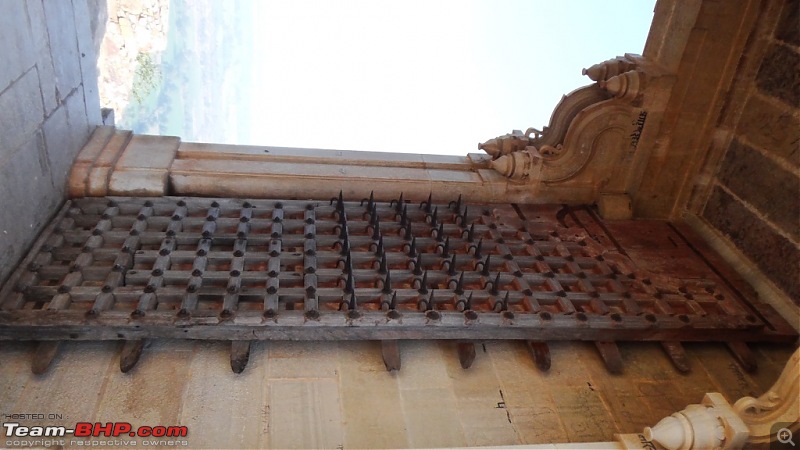 And now we come to the last destination of the journey, the Kirti Stambha.  Quite a stunning structure, older than the other monuments.  History.  A shiva temple from a different era, built next to the Kirti Stambha.  And finally, we reach the end of the trip. A long, featureless road takes us to the end of Chittor and out of the fort.  On the way back, my wife takes the wheel. Her first highway drive, the entire way to Udaipur. I lie back, close my eyes and relive the great Chittor once again.  |
| |  (11)
Thanks (11)
Thanks
|
| The following 11 BHPians Thank predatorwheelz for this useful post: | cityvic, darklord, Ddrive, JoseVijay, pulsar56, sdp1975, Shreyans_Jain, SS-Traveller, toiingg, vrprabhu, Wanderers |
| | #13 |
| Senior - BHPian Join Date: Feb 2004 Location: GTA
Posts: 14,770
Thanked: 2,705 Times
| Re: A week's drive through Rajasthan - The bastions of the Mewar Kingdom Thread moved from the Assembly Line to the Travelogues Section. Thanks for sharing! |
| |  ()
Thanks ()
Thanks
|
| | #14 |
| BHPian Join Date: Sep 2013 Location: Hyderabad
Posts: 993
Thanked: 481 Times
| Re: A week's drive through Rajasthan - The bastions of the Mewar Kingdom WOW. Awesome. One of the Best and the most detailed travelogues I have ever come across on the forum  . Pictures speak a thousand volumes about the History of this great place . Pictures speak a thousand volumes about the History of this great place  . . |
| |  (1)
Thanks (1)
Thanks
|
| The following BHPian Thanks JoseVijay for this useful post: | predatorwheelz |
| | #15 |
| BHPian Join Date: Jun 2013 Location: Chennai
Posts: 254
Thanked: 534 Times
| Re: A week's drive through Rajasthan - The bastions of the Mewar Kingdom Fantastic one. Lovely photos and apt narrations. The structures amaze me... really how passionate those kings are, and rather you in bringing those for us to see. Thanks a ton. A wonderful travelogue sir. |
| |  (1)
Thanks (1)
Thanks
|
| The following BHPian Thanks Ddrive for this useful post: | predatorwheelz |
 |

